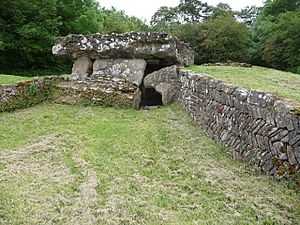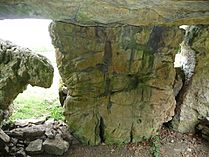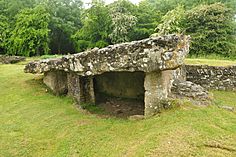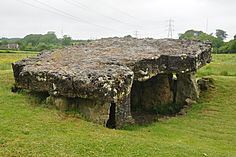Tinkinswood facts for kids
 |
|
| Location | St Nicholas and Duffryn Rural Communities |
|---|---|
| Region | Vale of Glamorgan (Bro Morgannwg), Wales (Welsh: Cymru) |
| Coordinates | 51°27′4.96″N 3°18′29.17″W / 51.4513778°N 3.3081028°W |
| Type | Dolmen |
| History | |
| Periods | Neolithic |
| Site notes | |
| Condition | good with some damage |
| Official name | Tinkinswood Burial Chamber |
| Reference no. | 1015325 |
Tinkinswood is an ancient stone structure in Wales. Its full name is Tinkinswood Burial Chamber. People also call it Castell Carreg, Llech-y-Filiast, or Maes-y-Filiast. This amazing place is a type of megalithic tomb called a burial chamber. It was built about 6,000 years ago. This was during the Neolithic period, also known as the New Stone Age. You can find it in the Vale of Glamorgan, close to Cardiff, Wales.
This structure is a dolmen, which was a common type of stone monument in Europe. Tinkinswood is part of a group called the Severn-Cotswold tombs. It has a very large stone on top, called a capstone. Smaller upright stones hold this huge capstone up. The capstone at Tinkinswood is made of limestone. It weighs about 40 long tons! That's like 40 small cars. It measures about 24 feet (7.3 meters) long and 14 feet (4.3 meters) wide. It is thought to be the biggest capstone in Britain and even in Europe. Imagine how hard it was to lift! It probably took around 200 people to get it into place.
Originally, the entire structure was covered by a mound of soil. Over many years, this soil has worn away. What's left of the mound behind the stones is still quite large. It measures about 130 feet (40 meters) long and 59 feet (18 meters) wide.
History of Tinkinswood
Tinkinswood was once a small village area. Now, only the burial chamber remains. It was built around 6,000 years ago. This was about 1,000 years before famous places like Stonehenge were built!
In 1914, archaeologists dug up the site to learn more. Inside the chamber, they found 920 human bones. Most of these bones were broken. This showed that at least forty people were buried there during the Neolithic period. These people were of all ages and genders. It seems this burial chamber was used by the whole community. It's thought that bodies were left outside for a while before being moved into the chamber.
Archaeologists also found pottery from the Neolithic period and the Bell-Beaker style. This tells us that the burial chamber was used by the community for a very long time. It might have been used even up until the early Bronze Age. During the excavation, some repair work was also done. A brick pillar was built to help support the heavy capstone.
From the burial chamber, two lines of stones stretch out to the southeast. These form a kind of ancient pathway. Another path of many stones goes to the northeast. A large single stone stands to the east. Two flat, parallel standing stones point towards a nearby hill called Coed Sion Hill.
The site is looked after by Cadw. Cadw is a group from the Welsh Government. Their job is to protect and share the history of Wales. In 2011, new excavations started at Tinkinswood to learn even more.
Myths and Legends
Many stories and legends about Tinkinswood are also linked to the nearby St Lythans burial chamber. This other ancient site is just a short distance away.
One legend says that if you spend a night at Tinkinswood, you might have a strange experience. This is said to happen on the evenings before May Day, St John's Day (June 23), or Midwinter Day. The legend claims you would either die, go crazy, or become a poet! This story is similar to old tales about spending a night on certain mountain tops.
Another legend is about a group of boulders to the southeast of the monument. People say these stones were once women. They were turned to stone because they were dancing on the Sabbath day. This is a common legend connected to dolmens in many places.





